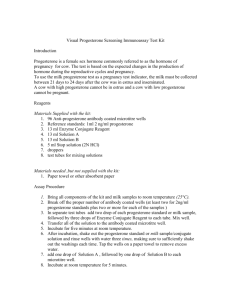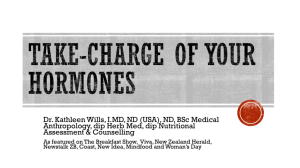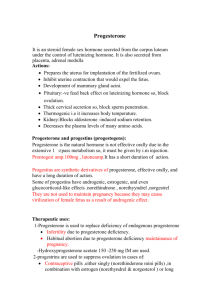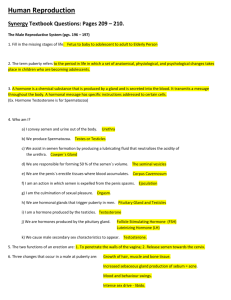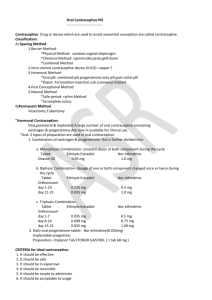YS_Synthesis of dl-Progesterone
advertisement
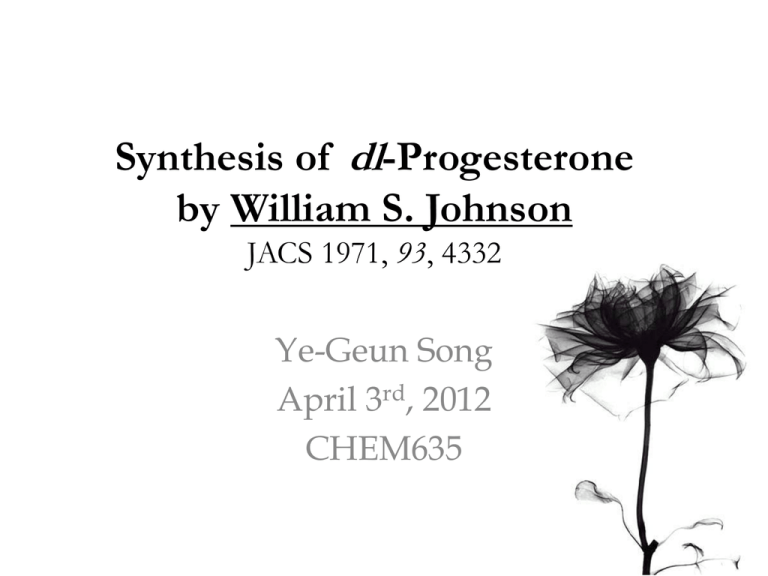
Synthesis of dl-Progesterone by William S. Johnson JACS 1971, 93, 4332 Ye-Geun Song April 3rd, 2012 CHEM635 William S. Johnson February 24, 1913 - August 19, 1995 • He did his undergraduate studies at Amherst College. • He finished his doctoral work with Prof. Louis Fieser at Harvard University in 1939 and did postdoctoral work at Harvard with Prof. R. P. • He began his independent academic career at the University of Wisconsin in 1940. – A full professor in 1946 – Elected to the Board of Editors of Organic Synthesis in 1948 – Elected to the National Acadamny of Sciences in 1958 • Moved to Stanford in 1960. • He did important research in the artificial production of steroids and was awarded the National Medal of Science in 1987. What is Progesterone? • Progesterone is a C-21 steroid hormone involved in menstrual cycle, pregancy, and embryogenesis of mammals and is the major naturally occuring human progestogen. • Progesterone is commonly manufactured from the Dioscorea (a family of yam), which produces large amounts of a steroid called diosgenin that can be converted into progesterone. • Like other steroids, progesterone consists of four interconnected cyclic hydrocarbons with ketone and oxygenated functional groups, as well as two methyl branches. Why are we interested in making it? • Progesterone can be used as a part of hormone replacement therapy in women who have passed menopause to treat symptoms of menopause and reduce the risk of developing certain hormone related diseases. • Estrogen is often used in the therapy but can also cause abnormal thickening of the lining of the uterus and increase the risk of developing uterine cancer. Progesterone helps to prevent this thickening and decreases the risk of the cancer. • Progesterone is also used to bring on menstruation in women who should have normal periods by replacing the natural progesterone that some women are missing. A Big Picture of Johnson’s Synthesis 11 was produced by a convergent synthesis: The key step is a stereoselective Wittig condensation of the aldehyde 4 with the ylide 7 to produce diketal 8. (Scheme 1) The Synthesis of Aldehyde 4 (Scheme 2) The Synthesis of Ylide 7 (Continued) Finkelstein Rxn: The classic Finkelstein reaction involves the conversion of an alkyl chloride or an alkyl bromide to an alkyl iodide by the addition of NaI in acetone. Because NaI is soluble in acetone and NaCl and NaBr are not, the equilibrium is shifted by the precipitation of the insoluble salt. Example: CH3CH2Br (acetone) + NaI (acetone) → CH3CH2I (acetone) + NaBr (s) (Scheme 3) The Synthesis of Progesterone 14 Conclusion • Acetylenic bond participating in an olefinic cyclization to produce trans-fused five membered ring in one step • Simple starting materials
